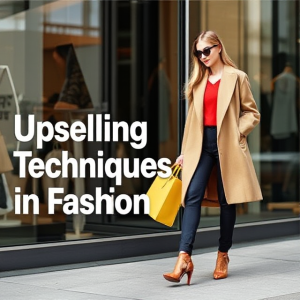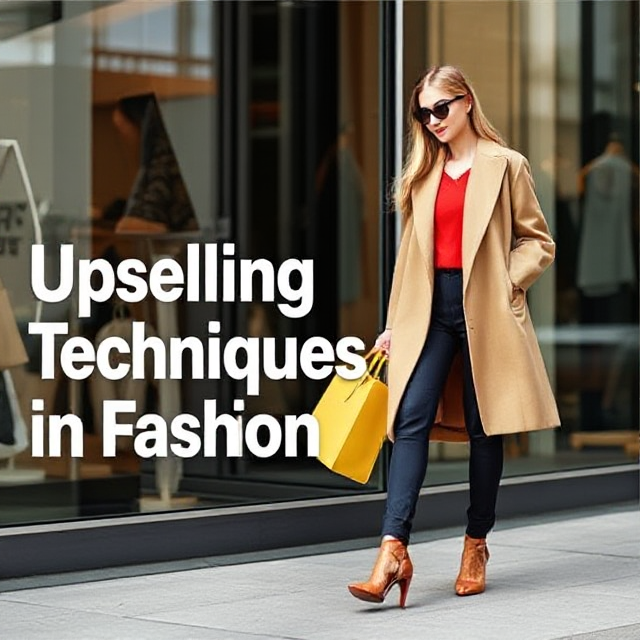
Upselling is a powerful sales strategy that encourages customers to purchase more expensive items or upgrade their existing choices. In the fashion industry, where trends, customer loyalty, and personalization play a significant role, upselling is an essential technique for boosting revenue and improving customer satisfaction. This article explores various upselling techniques that can be applied in fashion retail, offering insights into how fashion brands, online stores, and salespeople can effectively use this strategy.
What is Upselling?
Upselling involves persuading customers to buy higher-end products or additional items that complement their initial purchase. This strategy not only enhances the overall customer experience but also maximizes the average order value, leading to increased profits. While upselling is typically associated with larger purchases, it can be applied in various forms within the fashion industry, whether through better-quality materials, accessories, or premium versions of a product.
Why Upselling Works in Fashion
- Emotional Connection: Fashion is an emotional purchase. Consumers often buy items because they make them feel confident, stylish, or part of a particular trend. Upselling taps into these emotions by presenting a higher-quality or more exclusive item that appeals to the consumer’s desire for luxury, status, or individuality.
- Personalization: The fashion industry thrives on personalized experiences. By understanding a customer’s preferences, purchase history, and style, retailers can offer upsell opportunities that feel tailored and relevant to the individual.
- Bundling: In fashion, accessories and complementary items (like shoes, bags, or jewelry) are essential upselling products. These items often add value to a customer’s look and are seen as an opportunity to enhance their overall wardrobe.
Effective Upselling Techniques in Fashion
- Product Bundling
Product bundling is one of the most popular and effective upselling techniques in fashion. By grouping related items, such as a pair of shoes with a matching handbag, retailers encourage customers to buy additional products. Offering a discount on the bundle creates a sense of value, while also boosting sales of items that may not sell as well individually.- Example: A store could pair a winter jacket with a scarf, gloves, and a beanie, offering a 10% discount when the items are purchased together.
- Highlighting Premium Versions
When a customer expresses interest in a particular item, showcasing a premium version can be an effective way to upsell. For instance, if a shopper is looking at a regular cotton T-shirt, the salesperson might introduce a higher-end version made from sustainable fabrics, like organic cotton or luxury cashmere. Highlighting the benefits of upgrading, such as improved quality, durability, and eco-friendliness, can convince the customer to opt for the more expensive option.- Example: “This cotton T-shirt is great, but if you’re looking for something softer and more sustainable, we also have this organic cotton version with a more luxurious feel.”
- Personalized Recommendations
Utilizing data and customer insights allows retailers to offer more personalized upsell suggestions. Online stores, for example, can suggest items based on a customer’s browsing history or previous purchases. In-store, salespeople can recommend complementary items based on the customer’s style or preferences.- Example: An online fashion store can display “You might also like” sections featuring items that align with the customer’s previous purchases, such as adding a designer belt to go with a high-end dress.
- Limited-Time Offers and Exclusivity
Scarcity and exclusivity often drive demand in fashion. Introducing a limited-time offer or exclusive product can persuade customers to buy a higher-end version of an item. The idea that the product might sell out creates urgency and adds perceived value.- Example: A luxury brand might offer a limited-edition version of a handbag in an exclusive color, with the added benefit of early access for VIP customers or special promotions.
- Upselling through Visual Merchandising
How products are displayed in a store plays a crucial role in upselling. By strategically placing high-end items at eye level or in prominent areas, retailers increase the chances that customers will choose them. In addition, offering outfit inspiration—such as showcasing full looks with premium items—helps customers visualize the benefits of upgrading their choices.- Example: A boutique could create an in-store display featuring an entire high-end ensemble, with shoes, jewelry, and accessories, encouraging customers to purchase all items together to complete the look.
- Cross-Selling and Accessories
Cross-selling is closely related to upselling and involves encouraging the customer to buy additional items that complement their main purchase. In fashion, accessories like scarves, belts, shoes, or jewelry are common cross-sell items that can be used to increase the total sale value.- Example: A customer purchasing a dress might be offered a matching pair of earrings, a clutch bag, or a stylish jacket to elevate the look.
- Offering a Loyalty Program
Fashion brands often have loyalty programs that reward customers for making additional purchases. These programs can also be used as a tool for upselling by offering special perks like discounts on premium items or early access to new collections. This not only boosts sales but also fosters customer loyalty.- Example: “As a loyalty member, you can receive 15% off this exclusive collection if you upgrade to this premium version.”
- Using the Right Language and Approach
The way salespeople approach upselling in fashion can make all the difference. Instead of aggressively pushing a higher-priced product, a more subtle approach works best. Sales staff should highlight the unique qualities and benefits of the upsell item, showing how it meets the customer’s needs or enhances their style.- Example: “I think this jacket would look fantastic with your new jeans. It’s a versatile piece that you can wear throughout the season.”
Common Pitfalls to Avoid
- Overwhelming Customers: Offering too many upsell options can confuse customers and make them feel pressured. It’s important to offer products that align with their tastes, and not just push the highest-priced items.
- Ignoring Customer Needs: Upselling works best when the additional item truly fits the customer’s needs. Pushing irrelevant products, especially ones that don’t align with their preferences or style, can result in frustration and a negative shopping experience.
- Too Much Focus on Price: While upselling often involves higher-priced items, it’s important not to focus solely on price. Many customers are willing to spend more if the product offers value in terms of quality, craftsmanship, or exclusivity.
In the fashion industry, upselling is a vital technique for driving revenue and enhancing the customer shopping experience. By offering personalized recommendations, showcasing premium versions of products, bundling related items, and creating exclusivity, fashion retailers can encourage customers to make higher-value purchases. However, upselling should be done with care to avoid overwhelming the customer, ensuring that the upsell truly adds value to their experience. When done correctly, upselling not only increases sales but also fosters customer loyalty and satisfaction, making it a win-win for both the retailer and the shopper.
